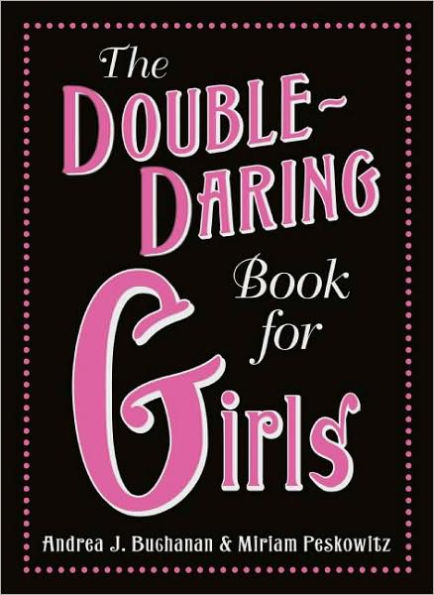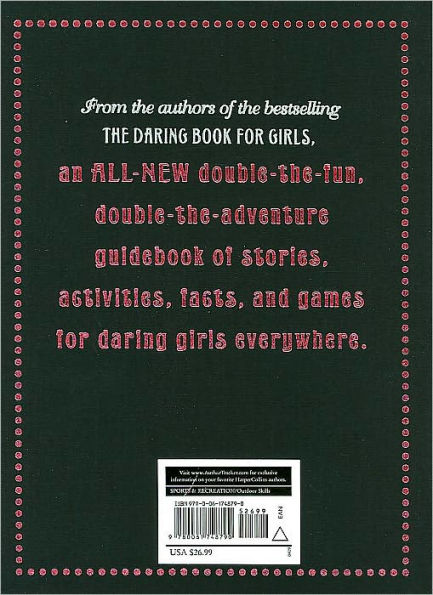Interviews
The Double Daring Book for Girls is full of all brand new activities. What was it like getting back out in the yard to test drive all of them?
Andi: Really fun -- the best part of working on a book like this is getting creative with all of the projects. I had a great time with both my kids making all manner of worry dolls and dreamcatchers -- our bedrooms are now well-stocked with pretty much anything necessary to ensure a good night's sleep! -- and my daughter had a blast using Kool-Aid to dye her hair. We decorated sundials together and practiced throwing footballs, slid across the floor in slippery socks to figure out who was "goofy footed" (useful to know when surfing or skateboarding), and had a blast playing card games like Spit and Spoons with some cousins who were eager to share their tips and tricks. And our house is festooned with all manner of scoubidoo chains -- the string-tying really got out of control at one point... Just as fun as playing games and making things together, though, were the conversations that came up in the process. Working on the chapter about picnic games, for instance, made me reminisce about my own experiences with "Field Day" as a not-so-daring elementary school girl, and it was great to share memories of that with my daughter and her friends; it opened up a whole conversation about bravery and courage on the playing field, as we talked about everything from the joys of winning a race to the angst of being picked last, to the importance of taking a chance and giving something a shot, to the low-pressure fun of each of our favorite silly summer-day games. In this and other conversations, we got to let each other into ourworlds a little, bonding over hula hoops and note-folding in a way strictly outside of the usual do-your-homework, brush-your-teeth everyday parent-kid conversations.
Miriam: Oh my gosh, it was like going to a carnival, and this time around, my older daughter, she's ten, was such a big help. We started last spring. We made a scarecrow (see the book for directions!) from scrap wood we found in the basement. Her clothing came from a recycling center near her grandma's house (but please don't tell anyone about the pillowcase we snatched from the laundry closet to make the scarecrow's head . . . .). We named our scarecrow Penelope. Unfortunately, a summer thunderstorm did her in, just a day later. We tinkered with the directions to make the spine even stronger, and as a result, the book's directions are much better.
And the stilts, there's a story there. One day, Andi and I were brainstorming. We were about half way through writing the chapters, and somehow we came up with an idea for a chapter called "How to Run Away and Join the Circus." We thought it would be a short and funny chapter, but what do you know, it soon changed into a long collection of advice on how to walk a high wire and how to juggle.
The most fun was coming up with directions to make stilts. I searched online, but everything I found was too complex, or too tall for most girls-when you're eleven and just starting out with wood-working projects or with stilt walking, you don't really need eight-foot tall stilts!
Clearly it was time to drag the jigsaw and the power drill out to the yard and come up with our own directions. I had already bought some six-foot lengths of wood from the hardware store, and within an hour or so of sawing, drilling, and scribbling notes, we had a terrific-and easy, way to make stilts!
And then there's How to Make a Rope Ladder (and tie it to a tree!) so you always have a quick way to get up and out of sight. This may come in handy when you're working a case as Private Eye!
Best of all, spring is coming, so girls everywhere can take to their own backyards, whether to try out our tips to handle a lacrosse net, throw a football, organize a lawn-bowling tournament, turn your backyard into a farm, or learn a slew of new picnic games (like water balloon volleyball, tug-of-war, or catch the baby).
And personally, I can't wait for the weather to really warm up so I can follow my own directions in the chapter on How to Go Car Camping!
The original Daring Book for Girls was a huge success. Did you hear from lots of girls about the book and how has that impacted the contents of the new book?
Miriam: Thanks. We did hear from lots of girls, and lots of moms and dads, and we read lots of bloggers, young and old, who wrote about trying things out. (We especially enjoyed one blogging dad who wrote about making a zipline in his backyard, using the directions from one of the Pocket Daring Books.) We always get lots of suggestions for chapter titles, and often we try them out. There's a special magic to putting together a sequel to the Daring Book for Girls, and the inspiration comes from all over, and from within.
I'll tell you, the chapter on Friendship comes right out of the ways we hear girls talk about their daily lives. Especially in the years between seven and fourteen, the ins-and-outs of friendship are something we hear girls talk about and stress over. There's still so many negative experiences that girls have then, and our Friendship chapter truly comes from our hearts: we really hope that girls can figure out from an early age how to be kind to one another so everyone can experience the best that friendship can offer.
Andi: We do get emails from girls who are excited to share their reaction to the book, and to suggest ideas. It's always wonderful to hear from readers -- and especially good to know when we're on the right track with something. I remember just a few days after we had been brainstorming about a chapter about running off to join a circus, with stilt-walking and funambulism and everything, a reader emailed to suggest that in a future book we include a chapter on walking on stilts! It was great to know we were on to something girls would be interested in knowing, and great to be able to let the reader know we were indeed already on the case.
What was each of your favorite activities from the new book and why?
Andi: That's a hard one! Doing batik reminded me of summer camp, for sure; learning furoshiki was fantastic fun (it's like origami, but with fabric -- plus, I learned how to wrap a watermelon!); scoubidoo was something I always wanted to get the hang of, so doing that was a blast; writing about "putting on a show" transported me back to the days when my sisters and I would script and perform hours of entertainment for ourselves and an audience of stuffed animals (and sometimes parents). I wish I could say that writing about playing pool has made me a better player, but I can definitely say that it was fun to write about (and humbling to hang out with 9- and 10-year-old budding pool sharks who could easily beat me in a game of eight-ball). And I loved tracking down trivia like the longest and shortest words, researching the origin of phrases like "happy as a clam," and compiling examples of optical illusions. It's impossible to choose!
Miriam: Now that's an impossible question-I have so many favorites, but: Fishing. When I was a kid I would go fishing with my dad. Last summer, we convinced him to pull down the old fishing rods and dust them off and lead a fishing expedition. The first stop was the local bait store to buy a pail and some frozen minnows and find out when high tide was coming in. We'd drive to a place called Second Bridge, and once again he taught me-and my older daughter and some of her friends-how to catch fish. He taught us when to throw back, and how to clean the ones you want to eat for dinner that night. It was snapper galore!







